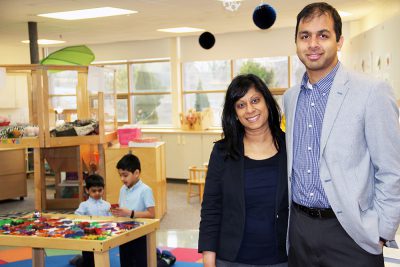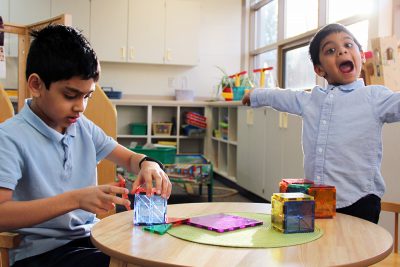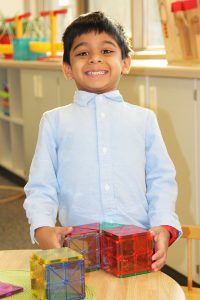February 20, 2017
 Neelu Boddipalli and her husband Rama never thought they’d consider private schools for their sons Dilan and Kelvyn. Neelu grew up in the Twin Cities and appreciated her public school education in South Washington County; Rama attended public schools in the western suburbs of Chicago. When the couple built a house in a Saint Paul suburb, they assumed their children would attend public school.
Neelu Boddipalli and her husband Rama never thought they’d consider private schools for their sons Dilan and Kelvyn. Neelu grew up in the Twin Cities and appreciated her public school education in South Washington County; Rama attended public schools in the western suburbs of Chicago. When the couple built a house in a Saint Paul suburb, they assumed their children would attend public school.
“Private school was never on the radar,” said Neelu. “But several factors collided, which prompted us to consider alternative options.”
Like many parents, the Boddipallis first connected with the local school district when their oldest son, Kelvyn, was about to enter kindergarten. Similar to many rapidly expanding suburbs, their school district was examining how best to manage capacity. The couple attended the district’s facility planning meetings to better understand the rezoning process. The Boddipallis found themselves at odds with the district’s plans.
At the same time, their then-preschool son was experiencing racism and bullying at an area Montessori school, and it was eroding Kelvyn’s confidence.
“We watched in shock as our son changed from being extroverted and lively to being introverted and angry,” recalled Neelu. “Given this experience, we wondered if the public school would be the right fit given large class sizes. We felt we needed to put him in an environment that provided a smaller student-teacher ratio and greater support from an emotional development perspective.”
Exploring all the Options
The Boddipallis took a broad approach to school choice, exploring, private, public, charter, magnet and immersion schools. They struggled with how best to narrow their options; options they felt fortunate to have.
The Boddipallis systematically and thoroughly explored potential schools, even using a spreadsheet to compare their options. They then measured the schools based on the couple’s highest priorities: inclusiveness, a small student-teacher ratio, and promotion of diversity. After visiting every potential school, the couple found that private schools were the best fit for their family.
“When private schools rose to the top of our list, and we committed to making a financial investment in our children’s education, the conversation changed,” reflected Neelu. “We focused on comparing the area’s top private schools, including Mounds Park Academy.”
 Choosing Mounds Park Academy
Choosing Mounds Park Academy
The Boddipallis found that all of the private schools they examined were very academically focused. But in the end, they felt there was little variance in what their son would be learning at the Lower School level. Instead, the Boddipallis looked beyond academics.
“We loved the focus on the whole child at MPA,” explained Neelu. “We loved the school’s emphasis on character and skills like critical thinking, communication, collaboration, and creativity. We have seen the confidence return to our son.”
Another deciding factor for Neelu and Rama was the strong parent community at MPA. They knew that they wanted to be involved in the school community, so they wanted an environment that was warm and welcoming.
“I have never seen such outreach, involvement, and passion coming from a parent community at a school like I did at MPA,” said Neelu. “When I look at the first-grade class, I feel like the parents and students are there for each other, which makes us feel welcome and included.”
In addition to the whole child focus and the inclusive community, the Boddipallis loved MPA’s interdisciplinary approach to teaching and learning. Neelu noted that all of the teachers are experts in their subject matter, and they work together to weave a concept across different disciplines to develop projects that are creative and demonstrate a practical application to the topic at hand. Neelu mentioned that she was particularly impressed with a recent project on weather that brought math, science, and literature together; she didn’t know that it was being featured the next day in the MPA article, First Graders Save Jack Using Design Thinking.
What finally clinched the decision for the Boddipallis was that all of the schools—the Lower School, Middle School and Upper School—are all in one building at MPA.
“Having all of the schools in one building creates a unique environment,” observed Neelu. “The school does a great job leveraging cross-grade interactions, pairing up kids across grades for different activities. We love that kids are learning from other kids in a way that typically doesn’t happen in traditional schools.”
 Finding the Right Fit
Finding the Right Fit
When parents are in a position to consider schools for their children beyond the public schools, they have an opportunity to find the right fit. From a professional perspective, many people weighing a job offer will determine if the work environment is a good fit for their experience, work style, and personality; culture is a critical factor in the decision.
“Many parents overlook school culture,” remarked Neelu. “For us, culture was a big part of the decision. With its inclusive environment and the interaction across the grades, MPA has a distinct culture that is a welcoming extension of our home. When we drop our kids off, we’re dropping them off to people who are caring for them, not just educating them.”
The Boddipallis’ experience with MPA mirrors how MPA’s Director of Admission Craig Dodson describes MPA.
“We believe that a child’s success depends on strong partnership, mutual respect, open communication, and support between parents and the school,” said Dodson. “Families choose MPA because we offer a welcoming, inclusive, and safe environment with an unassuming culture that draws students from many different backgrounds.”
MPA families hail from almost 50 different zip codes and 60 different cities, concentrated primarily in the east, southeast, and northeast Twin Cities metro area. During the admission process, Dodson shares a significant amount of information with prospective families and encourages students and parents alike to ask a lot of questions. He wants to ensure that MPA is going to be a good fit for each student, both academically and socially.
“MPA is a community that parents and students choose to join,” said Dodson. “If parents are going to make the investment in our school from a time, financial, and emotional perspective, we want to it be the place where their child would be the most successful.”
In the annual survey of new families, most families cite that they like MPA because it is not only academically challenging, but also is a place that truly caters to all students’ needs.
“MPA students can be deeply involved in the arts and be a strong athlete,” said Dodson. “Or they can be into math and history–it’s all celebrated at MPA.”
 Personalizing the Admissions Process
Personalizing the Admissions Process
For Dodson, there are two core values in MPA admissions: making school-selection a personal process and making it a transparent one.
When Dodson and his team sit down with families, they want to get to know them and understand what’s important to them in a school, their child’s educational home. Students will spend half of their life at MPA, and Dodson wants families to be comfortable with their choice on all levels. He encourages families to visit MPA, meet with teachers, visit classes, speak to other parents, and attend school events to ensure that MPA is the right fit for their child.
“We are fortunate to live in an area where there are so many tremendous educational options for students of all ages,” said Dodson. “We are very forthcoming about who we are—and who we are not—and we believe it is our duty to share that with prospective families. We believe that we have a responsibility to protect and promote the culture that we espouse here at MPA.”
The spring admission deadline for the 2017–18 school year is April 15, 2017. For more information, please contact the Office of Admission via email or at 651-748-5577.